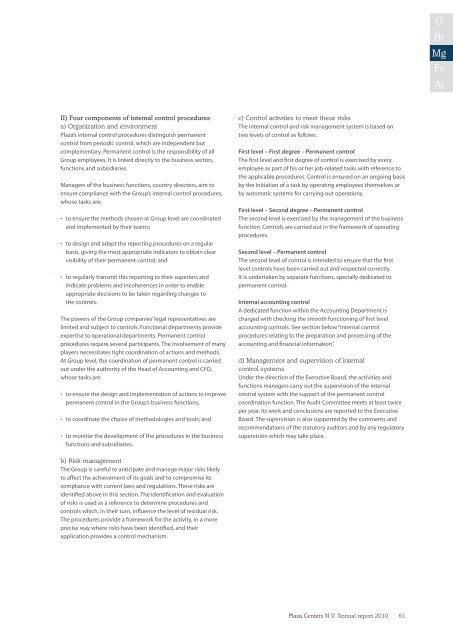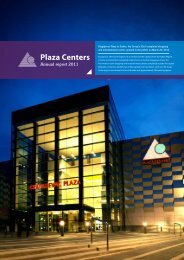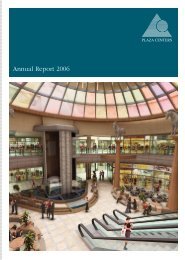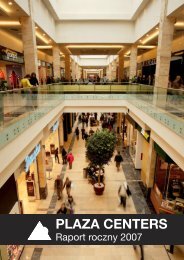Annual report 2010 - plazacenters
Annual report 2010 - plazacenters
Annual report 2010 - plazacenters
You also want an ePaper? Increase the reach of your titles
YUMPU automatically turns print PDFs into web optimized ePapers that Google loves.
O<br />
Br<br />
Mg<br />
Fs<br />
Ai<br />
II) Four components of internal control procedures<br />
a) Organization and environment<br />
Plaza’s internal control procedures distinguish permanent<br />
control from periodic control, which are independent but<br />
complementary. Permanent control is the responsibility of all<br />
Group employees. It is linked directly to the business sectors,<br />
functions and subsidiaries.<br />
Managers of the business functions, country directors, aim to<br />
ensure compliance with the Group’s internal control procedures,<br />
whose tasks are:<br />
• to ensure the methods chosen at Group level are coordinated<br />
and implemented by their teams;<br />
• to design and adapt the <strong>report</strong>ing procedures on a regular<br />
basis, giving the most appropriate indicators to obtain clear<br />
visibility of their permanent control; and<br />
• to regularly transmit this <strong>report</strong>ing to their superiors and<br />
indicate problems and incoherences in order to enable<br />
appropriate decisions to be taken regarding changes to<br />
the controls.<br />
The powers of the Group companies’ legal representatives are<br />
limited and subject to controls. Functional departments provide<br />
expertise to operational departments. Permanent control<br />
procedures require several participants. The involvement of many<br />
players necessitates tight coordination of actions and methods.<br />
At Group level, the coordination of permanent control is carried<br />
out under the authority of the Head of Accounting and CFO,<br />
whose tasks are:<br />
• to ensure the design and implementation of actions to improve<br />
permanent control in the Group’s business functions;<br />
• to coordinate the choice of methodologies and tools; and<br />
• to monitor the development of the procedures in the business<br />
functions and subsidiaries.<br />
c) Control activities to meet these risks<br />
The internal control and risk management system is based on<br />
two levels of control as follows:<br />
First level – First degree – Permanent control<br />
The first level and first degree of control is exercised by every<br />
employee as part of his or her job-related tasks with reference to<br />
the applicable procedures. Control is ensured on an ongoing basis<br />
by the initiation of a task by operating employees themselves or<br />
by automatic systems for carrying out operations.<br />
First level – Second degree – Permanent control<br />
The second level is exercised by the management of the business<br />
function. Controls are carried out in the framework of operating<br />
procedures.<br />
Second level – Permanent control<br />
The second level of control is intended to ensure that the first<br />
level controls have been carried out and respected correctly.<br />
It is undertaken by separate functions, specially dedicated to<br />
permanent control.<br />
Internal accounting control<br />
A dedicated function within the Accounting Department is<br />
charged with checking the smooth functioning of first level<br />
accounting controls. See section below “Internal control<br />
procedures relating to the preparation and processing of the<br />
accounting and financial information”.<br />
d) Management and supervision of internal<br />
control systems<br />
Under the direction of the Executive Board, the activities and<br />
functions managers carry out the supervision of the internal<br />
control system with the support of the permanent control<br />
coordination function. The Audit Committee meets at least twice<br />
per year. Its work and conclusions are <strong>report</strong>ed to the Executive<br />
Board. The supervision is also supported by the comments and<br />
recommendations of the statutory auditors and by any regulatory<br />
supervision which may take place.<br />
b) Risk management<br />
The Group is careful to anticipate and manage major risks likely<br />
to affect the achievement of its goals and to compromise its<br />
compliance with current laws and regulations. These risks are<br />
identified above in this section. The identification and evaluation<br />
of risks is used as a reference to determine procedures and<br />
controls which, in their turn, influence the level of residual risk.<br />
The procedures provide a framework for the activity, in a more<br />
precise way where risks have been identified, and their<br />
application provides a control mechanism.<br />
<br />
Plaza Centers N.V. <strong>Annual</strong> <strong>report</strong> <strong>2010</strong>61








